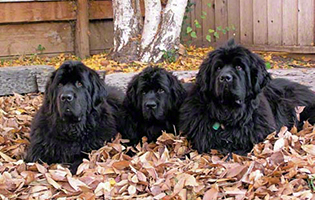by Clyde Dunphy, DVM
The simplest way to remember whether or not to call your vet is to think "If it was me, would I call my doctor". If the answer is yes, call your vet! The same basic rules for human first aid apply to dogs. Be as observant as possible and make notes. Your dog cant speak so you must be both his eyes and voice to help the doctor diagnose the problem. "He doesn't feel good" wont help the vet, but -- "he's been off his feed for a day, is drinking tons of water, urinating a lot and has a temperature of 102.5" will give your vet more to go on.
This also applies to trauma. A frantic call saying "he's bleeding" means little or nothing. On the other hand "He was attacked by another dog and is bleeding heavily from a puncture wound on his left flank. His eyes are glazed and he's panting heavily" tells another story. With a little training from your vet you and he can work hand-in-hand to diagnose your dog.
Lets start with the basics.
INJURY: No matter what the injury, approach your dog with caution. A dog that normally will not bite, may bite when in pain. To be safe, use a muzzle. The most common is one made from the leg of a pair of stockings. Wrap it around the muzzle starting from underneath, around the top then back underneath. Pull snug then tie behind the head. A word of caution - do not apply a muzzle if the dog has any injury to the mouth or nose.
BLEEDING: Controlling hemorrhage is important if excessive bleeding is present. It is best controlled by a pressure bandage. A pressure bandage is a clean towel (or other clean material) applied directly to the wound with slight pressure. If the injury is on a limb you can use a tourniquet. Remember to release the tourniquet every couple of minutes to allow blood flow to the limb.
SHOCK: Signs of shock are muscular weakness, rapid heart rate, pale mucus membranes, rapid shallow breathing, reduced pulse rate, and blood pressure. To treat shock, keep the dog warm (wrap in a blanket) and quiet, and control any hemorrhage.Injury, bleeding and shock are very serious and after taking the initial basic steps call your vet and transport immediately.
You might want to try putting all your dog first-aid supplies in a plastic container with a tight fitting lid. Write your vets phone number on the top with a permanent marker so you wont waste any time looking for it in an emergency. Your first-aid kit could contain
Rectal Thermometer: Normal rectal temperature is 101-102 degrees.
Peroxide: For flushing wounds, can be used to induce vomiting. Pour 1-2 tablespoons in the back of the throat, repeat until dog vomits.
Kaopectate or Pepto-Bismol: 1 teaspoon per 25 pounds. Repeat every 4-6 hours. Tablets can be used following adult dosage for a 100 pound Newfoundland.
Murine, Murine +, or Boric Acid Solution: Flush eyes as needed.
Neosporin: Antibiotic ointment for scrapes and minor wounds such as tick removal sites.
Aspirin: Dosage of one tablet per 25 pounds, maximum of 3 tablet s every 4-6 hours. DO NOT use Tylenol, Advil or other anti-inflammatories as they are toxic to a dogs liver and kidneys.
Benadryl: Use for allergic reactions, allergies, ho spots. Dosage is 25 mg capsule per 15-20 pounds. For a Newfoundland that is 100-140 pounds, try 100 mg (can be increased if needed). Repeat every 4-6 hours as needed.
Old pair of pantyhose: Makes a great muzzle.
Leash and Collar: They just might come in handy.
Clean bath towel: Good for pressure bandages.
Ace-type bandage: Can be used to hold pressure bandage in place, splint broken limbs.
There are other items that should be included depending on what part of the country you live in. Speak with your vet and find out what he would like you to include. As with most medical items, keep out of reach of children.
Remember, you and your vet are the first line of defense when it come to the health of your dog. Work together - it will benefit your four-footed family member.


Clicking each link will allow you to purchase the item through Amazon.com, commissions earned from each sale benefit the NCA Newfoundland Health Challenge and the NCA National Newfoundland Rescue Network.